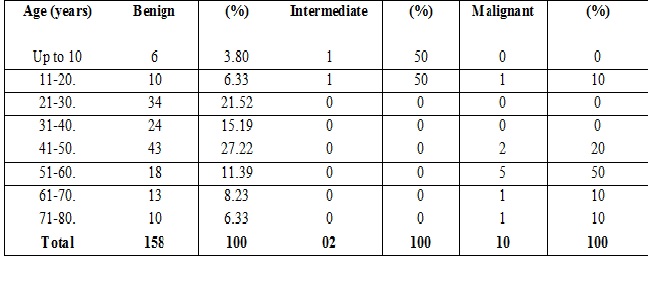Study of histopathological pattern of soft tissue tumours in tertiary care centre of Gandhi Nagar, Gujarat
Abstract
Background: Soft tissue tumours are a diverse and fascinating group of lesions that arise from the supporting soft tissue of the body. Although pathologically diverse, they frequently exhibit similar clinical presentations and radiological features. Correct histopathological diagnosis is therefore crucial.
Aims and objectives: This study aims to analyze the histopathological patterns of soft tissue tumours and their distribution according to age, sex and site of occurrence in patients.
Methods: This study comprised of 170 cases of soft tissue tumours received in the Department of Pathology, GMERS Medical College, Gandhinagar were analysed. Their gross features, microscopic findings were analysed in detail. Soft tissue tumours were divided into benign and malignant categories and their further sub typing were done according to WHO Classification. The distribution of soft tissue tumours according to the age, sex and site of occurrence was studied.
Results: Out of 170 cases of soft tissue tumours, 158 cases (92.4%) were benign, 2 cases (1.18%) were malignant and 10 cases (5.88%) were classified under intermediate category. Adipocytic tumors formed the largest group constituting 92 cases (46%). Vascular tumors were the second commonest (7%) followed by peripheral nerve sheath tumours (10.5%). The benign tumours were seen in younger age as compared to malignant tumours.
Conclusion: Benign tumours were more common than malignant. The most common benign tumours were lipoma followed by hemangioma (14.0%) and schwannoma (5.5%). There is wide range of their distribution according to age, sex and site. The benign tumours were seen in younger age as compared to malignant tumours.
Downloads
References
2. Weiss SW, Goldblum JR. General Considerations.In: Schmitt W, Black S, MacSween L, editors. Soft Tissue Tumors. 5th ed .Philadelphia: Mosby Elsevier. 2008;1-14.
3. Thway K. Pathology of soft tissue sarcomas. Clin Oncol (R Coll Radiol). 2009 Nov;21(9):695-705. doi: 10.1016/j.clon.2009.07.016. Epub 2009 Sep 6.[pubmed]
4. Kathrin Katenkamp, Detlef Katenkamp. Soft tissue tumour – New perspectives on classification and diagnosis. Dtsch Arztebl Int. 2009 Sep; 106(39):632-6. Doi: 10.3238/arztebl.2009.0632
5. Jemal A, Siegel R, Ward E, et al. Cancer statistics, 2006. CA Cancer J Clin. 2006 Mar-Apr;56(2):106-30.[pubmed]
6. Fletcher CDM, Sundaram M, Rydholm A, CoindreJM,Singer. Soft Tissue Tumors: Epidemiology, clinical features, histopathological typing and grading. In: Fletcher CDM, UnniKK, Mertens F, editors. Pathology and Genetics of Tumors of Soft Tissue and Bone. Lyon: IARC. 2002;12-18.
7. Agarwal V, Greenebaum E, Wersto R, et al. DNA ploidy of spindle cell soft-tissue tumors and its relationship to histology and clinical outcome. Arch Pathol Lab Med. 1991 Jun;115(6):558-62.[pubmed]
8. Marcus SG, Merino MJ, Glatstein E, et al. Long-term outcome in 87 patients with low-grade soft-tissue sarcoma. Arch Surg. 1993 Dec;128(12):1336-43.[pubmed]
9. Fletcher CDM ,Unni KK , Mertens F (Eds): WHO classification of tumors:Pathology and genetics of soft tissue and bones.IARC press, Lyon 2002;p12-6
10. Preeti Rihal Chakrabarti, Suvadip Chakrabarti, Ajita Pandit, Purti Agrawal, Shilpi Dosi, Mukul Raj Jain. Histopathological study of soft tissue tumors: A three year experience in tertiary care centre. Indian Journal of Pathology and Oncology, July – September 2015;2(3);141-149
11. Stout AP. Tumors of the soft tissues. In: Atlas of Tumor Pathology, Section II, Fascicle 5, Armed Forces Institute of Pathology 1st ed. Washington, D.C: Armed Forces Institute of Pathology. 1953:p9-128.
12. Wibmer C, Leithner A, Zielonke N, et al. Increasing incidence rates of soft tissue sarcomas? A population-based epidemiologic study and literature review. Ann Oncol. 2010 May;21(5):1106-11. doi: 10.1093/annonc/mdp415. Epub 2009 Oct 25.[pubmed]
13. Trojani M, Contesso G, Coindre JM, et al. Soft-tissue sarcomas of adults; study of pathological prognostic variables and definition of a histopathological grading system. Int J Cancer. 1984 Jan 15;33(1):37-42.[pubmed]
14. Jemal A, Siegel R, Ward E, et al. Cancer statistics, 2007. CA Cancer J Clin. 2007 Jan-Feb;57(1):43-66.[pubmed]
15. Gustafson P. Soft tissue sarcoma. Epidemiology and prognosis in 508 patients. Acta Orthop Scand Suppl. 1994 Jun;259:1-31.[pubmed]
16. Ducimetière F, Lurkin A, Ranchère-Vince D, et al. Incidence of sarcoma histotypes and molecular subtypes in a prospective epidemiological study with central pathology review and molecular testing. PLoS One. 2011;6(8):e20294. doi: 10.1371/journal.pone.0020294. Epub 2011 Aug 3.[pubmed]
17. Makino Y. A clinicopathological study on soft tissue tumors of the head and neck. Acta Pathol Jpn. 1979 May;29(3):389-408.[pubmed]
18. Mastrangelo G1, Coindre JM, Ducimetière F, et al. Incidence of soft tissue sarcoma and beyond: a population-based prospective study in 3 European regions. Cancer. 2012 Nov 1;118(21):5339-48. doi: 10.1002/cncr.27555. Epub 2012 Apr 19.[pubmed]
19. Coindre JM, Terrier P, Guillou L, et al. Predictive value of grade for metastasis development in the main histologic types of adult soft tissue sarcomas: a study of 1240 patients from the French Federation of Cancer Centers Sarcoma Group. Cancer. 2001 May 15;91(10):1914-26.[pubmed]
20. Talati N, Pervez S. Soft tissue sarcomas: pattern diagnosis or entity? J Pak Med Assoc. 1998 Sep;48(9):272-5.[pubmed]
21. Harpal S, Richika, Ramesh K. Histopathological Pattern of Soft Tissue Tumours in 200 Cases. Ann. Int. Med. Den. Res. 2016; 2(6):PT06-PT11. doi: 10.21276/aimdr.2016.2.6.PT2



 OAI - Open Archives Initiative
OAI - Open Archives Initiative


